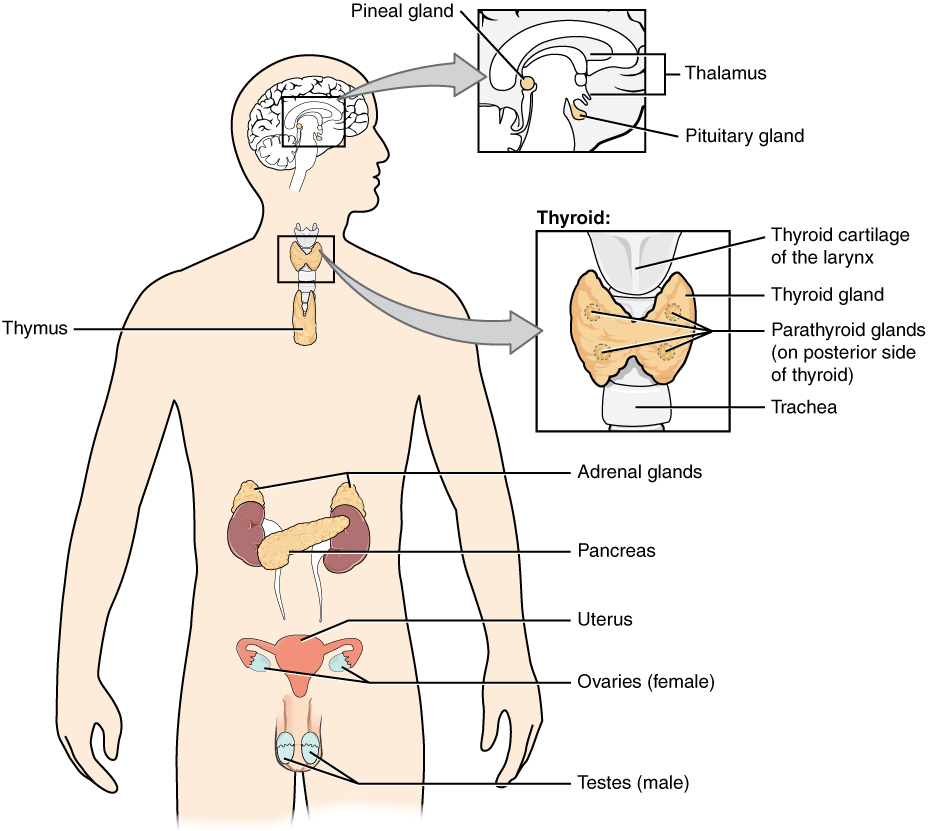17.1 An Overview of the Endocrine System
Learning Objectives
By the end of this section, you will be able to:
- Distinguish similarities and differences between neural and hormonal communication
- Identify the major organs of the endocrine system and their location in the body
Communication within the human body involves the transmission of signals to control and coordinate actions in an effort to maintain homeostasis. There are two major organ systems responsible for providing these communication pathways: the nervous system and the endocrine system.
The nervous system is primarily responsible for rapid communication throughout the body. As discussed in previous chapters, the nervous system utilizes two types of signals – electrical and chemical (Table 17.1). Electrical signals are sent via the generation and propagation of action potentials which move along the membrane of a cell. Once the action potential reaches the synaptic terminal, the electrical signal is converted to a chemical signal as neurotransmitters are released into the synaptic cleft. When the neurotransmitters binds with receptors on the receiving (post-synaptic) cell, a new electrical signal is generated and quickly continues on to its destination. In this way, neural communication enables body functions that involve quick, brief actions, such as movement, sensation, and cognition.
In contrast, the endocrine system relies on only a single method of communication: chemical signaling (Table 1). Hormones are the chemicals released by endocrine cells that regulate other cells in the body. Hormones are transported primarily via the bloodstream throughout the body, where they bind to receptors on target cells, triggering a response. Because of this dependence on the cardiovascular system for transport, this type of communication is much slower than that observed for neural signaling. As such, hormonal communication is usually associated with activities that go on for relatively long periods of time.
External Website

Visit this link to watch an animation of the events that occur when a hormone binds to a cell membrane receptor. What is the secondary messenger made by adenylyl cyclase during the activation of liver cells by epinephrine?
In general, the nervous system involves quick responses to rapid changes in the external environment, and the endocrine system is usually slower acting—taking care of the internal environment of the body, maintaining homeostasis, and controlling reproduction. This does not mean, however, that the two systems are completely independent of one another. Take for example the release of adrenaline from the adrenal medulla as part of the ‘fight-or-flight’ response. Although adrenaline uses blood for transportation throughout the body, the effects are evident within seconds after the event has occurred; how does the response happen so quickly if hormones are usually slower acting? It occurs so rapidly because the nervous and endocrine system are both involved in the process: it is the fast action of the nervous system responding to the danger in the environment that stimulates the adrenal glands to quickly secrete their hormones. In such a situation, the nervous system causes a rapid endocrine response to deal with sudden changes in both the external and internal environments when necessary.
Endocrine Organs
Hormones are released by secretory cells that are derived from epithelial tissue. Often, these cells are clustered together, forming endocrine glands. Unlike exocrine glands, which have a duct for conveying secretions to the outside of the body (e.g., sweat gland), endocrine glands secrete substances directly into the surrounding interstitial fluid. From there, hormones then enter the bloodstream for distribution throughout the body.
The major endocrine glands found in the human body include the pituitary gland, thyroid gland, parathyroid glands, thymus gland, adrenal glands, pineal gland, testes, and ovaries (Figure 17.1.1). While some of the glands are pure endocrine (e.g., thyroid gland), others serve both endocrine and exocrine function. For example, the pancreas contains cells that secrete digestive enzymes and juices into the small intestine (exocrine function) and cells that secrete the hormones insulin and glucagon, which regulate blood glucose levels.
In addition to the endocrine glands, major organs of the body show endocrine function including the hypothalamus, heart, kidneys, stomach, small intestine, and liver. Moreover, adipose tissue has long been known to produce hormones, and recent research has revealed a role for bone tissue in hormone production and secretion.

Other Types of Chemical Signals
In the classical definition of the endocrine system, hormones are secreted into the interstitial fluid and then diffuse into the blood or lymph for circulation throughout the body to reach target tissues. However, in certain instances, target cells are local and do not require hormones to enter the blood. If a chemical signal is released into the interstitial fluid and targets neighboring cells, then the activity is referred to as paracrine. Neurotransmitter communication between a pre- and post-synaptic neuron is a good example of paracrine activity. Alternatively, chemicals released by a cell elicit a response in the same cell that secreted it, demonstrating autocrine activity. An example of this is type of activity is Interleukin-1, signaling molecule released in an inflammatory response that binds to receptors located on the surface of the cell releasing the molecule.
Career Connections – Endocrinologist
Endocrinology is a specialty in the field of medicine that focuses on the treatment of endocrine system disorders. Endocrinologists, the medical doctors who specialize in this field, are experts in treating diseases associated with hormonal systems, ranging from thyroid disease to diabetes mellitus.
Patients who are referred to endocrinologists may have signs and symptoms or blood test results that suggest excessive or impaired functioning of an endocrine gland or endocrine cells. The endocrinologist may order additional blood tests to determine whether the patient’s hormonal levels are abnormal, or they may stimulate or suppress the function of the suspect endocrine gland and then have blood taken for analysis. Treatment varies according to the diagnosis. Some endocrine disorders, such as type 2 diabetes, may respond to lifestyle changes such as modest weight loss, adoption of a healthy diet, and regular physical activity. Other disorders may require medication, such as hormone replacement, and routine monitoring by the endocrinologist. These include disorders of the pituitary gland that can affect growth and disorders of the thyroid gland that can result in a variety of metabolic problems.
Some patients experience health problems as a result of the normal decline in hormones that can accompany aging. These patients can consult with an endocrinologist to weigh the risks and benefits of hormone replacement therapy intended to boost their natural levels of reproductive hormones.
In addition to treating patients, endocrinologists may be involved in research to improve the understanding of endocrine system disorders and develop new treatments for these diseases.
Chapter Review
The body coordinates its functions through two major types of communication: neural and endocrine. Neural communication includes both electrical and chemical signaling between neurons and target cells. Endocrine communication involves chemical signaling via the release of hormones which travel through the bloodstream, where they elicit a response in target cells. Endocrine glands are ductless glands that secrete hormones. Many organs of the body with other primary functions—such as the heart, stomach, and kidneys—also have endocrine activity.
Interactive Link Questions
Visit this link to watch an animation of the events that occur when a hormone binds to a cell membrane receptor. What is the secondary messenger made by adenylyl cyclase during the activation of liver cells by epinephrine?
cAMP
Review Questions
Critical Thinking Questions
1. Describe several main differences in the communication methods used by the endocrine system and the nervous system.
2. Compare and contrast endocrine and exocrine glands.
3. True or false: Neurotransmitters are a special class of paracrines. Explain your answer.
Glossary
- autocrine
- chemical signal that elicits a response in the same cell that secreted it
- endocrine gland
- tissue or organ that secretes hormones into the blood and lymph without ducts such that they may be transported to organs distant from the site of secretion
- endocrine system
- cells, tissues, and organs that secrete hormones as a primary or secondary function and play an integral role in normal bodily processes
- exocrine system
- cells, tissues, and organs that secrete substances directly to target tissues via glandular ducts
- hormone
- secretion of an endocrine organ that travels via the bloodstream or lymphatics to induce a response in target cells or tissues in another part of the body
- paracrine
- chemical signal that elicits a response in neighboring cells; also called paracrine factor
Solutions
Answers for Critical Thinking Questions
- The endocrine system uses chemical signals called hormones to convey information from one part of the body to a distant part of the body. Hormones are released from the endocrine cell into the extracellular environment, but then travel in the bloodstream to target tissues. This communication and response can take seconds to days. In contrast, neurons transmit electrical signals along their axons. At the axon terminal, the electrical signal prompts the release of a chemical signal called a neurotransmitter that carries the message across the synaptic cleft to elicit a response in the neighboring cell. This method of communication is nearly instantaneous, of very brief duration, and is highly specific.
- Endocrine glands are ductless. They release their secretion into the surrounding fluid, from which it enters the bloodstream or lymph to travel to distant cells. Moreover, the secretions of endocrine glands are hormones. Exocrine glands release their secretions through a duct that delivers the secretion to the target location. Moreover, the secretions of exocrine glands are not hormones, but compounds that have an immediate physiologic function. For example, pancreatic juice contains enzymes that help digest food.
- True. Neurotransmitters can be classified as paracrines because, upon their release from a neuron’s axon terminals, they travel across a microscopically small cleft to exert their effect on a nearby neuron or muscle cell.
This work, Anatomy & Physiology, is adapted from Anatomy & Physiology by OpenStax, licensed under CC BY. This edition, with revised content and artwork, is licensed under CC BY-SA except where otherwise noted.
Images, from Anatomy & Physiology by OpenStax, are licensed under CC BY except where otherwise noted.
Access the original for free at https://openstax.org/books/anatomy-and-physiology/pages/1-introduction.

